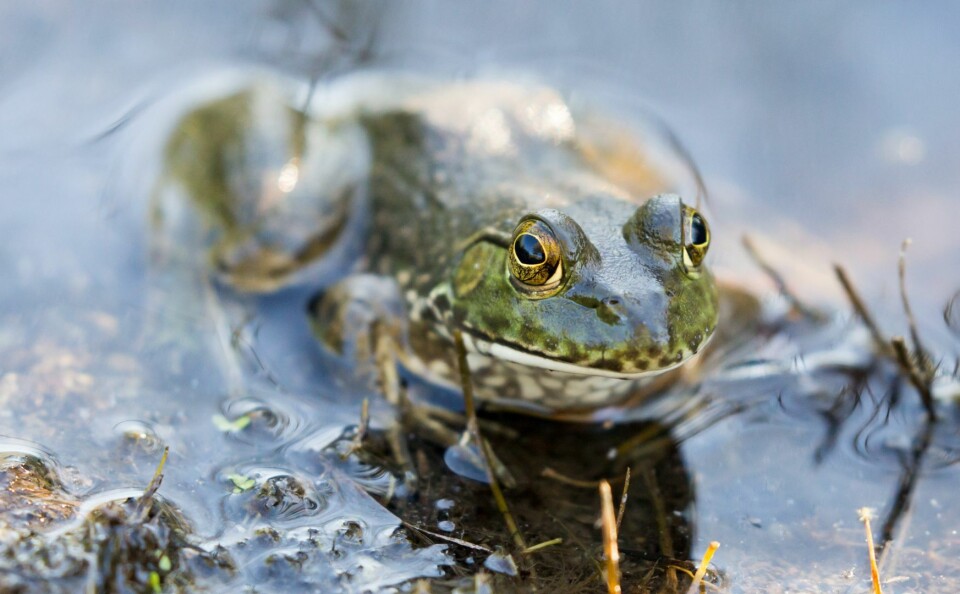-
Veggie burgers and plant-based sausages: French farmers and consumers react to name ruling delay
The EU failed to reach final agreement to draft rules governing plant-based naming
-
Hydroelectric conversions boost demand for historic French watermills
Laws on restoring rivers mean many are now threatened with removal
-
Millions of Perrier bottles blocked in south of France over bacteria concerns
Anomalies found at plant in Gard
Fears the Giant American bullfrog will damage native French wildlife
‘They eat anything, have no natural predator in France and are spreading’ says amphibian expert

Giant American bullfrogs, some weighing one kilogramme and with 25cm-long bodies, are now an established part of wildlife in wetlands around the Gironde and Dordogne rivers, leading to fears that they might damage native wildlife.
They were introduced in the 1960s by a collector who wanted to have them in a pond as a curiosity, but very quickly escaped into the wild.
The bullfrogs get their name because their mating cry sounds like the bellowing of a cow, and it is so loud it can easily be heard half a kilometre away.
Carry deadly fungus
Early studies by the nature association Cistude Nature in Nouvelle Aquitaine, showed that the frogs are widespread, and they have large appetites, eating anything they come across in the water, including their own tadpoles and smaller bullfrogs.
At the moment they coexist with other wildlife, but the worry is this might change as the population increases.
Another worry is that they carry a fungus which does not harm large specimens, but which is deadly for other amphibians.
No natural predator in France
“For me the essential problem is that they are voracious and eat anything, and when you think about it, their spread has been incredible,” said Thierry Chaudière, the herpetologist at the Aquarium du Périgord Noir, at Bugue-sur-Vézère, which takes in specimens people want removed from their gardens or property.
“In North America, where they originate, they are eaten by alligators and by some large snakes – but here the predator they have is people.
“Small snakes are among the prey they take in France.”
Hunting controls
Hunting frogs is strictly controlled in France and limited to a couple of weeks in the summer, to try and preserve native green frogs, and the bullfrogs can only be hunted at the same time as green frogs, other than for scientific purposes.
Most of the frogs’ legs bought in supermarkets are American bullfrogs which are raised commercially in Asia.
How to distinguish American Bullfrogs from native species
Mr Chaudière said the bullfrogs were also very discrete and good at hiding from humans, more so than native frogs, and most people have no idea that they are near.
“When all the frogs are singing, it takes someone with a trained ear to distinguish the noise from a bullfrog, and most people just do not realise the sound is different from the others,” he said.
Markings on the bullfrogs are a bit stronger than on native frogs, and apart from size, the main distinguishing feature between them is that native frogs have a raised fold in their skin across the whole length of their back, while bullfrogs do not.
Bullfrogs also come in a greater variety of colours, ranging from a dull dun green to a brilliant green.
Eradication attempts failed
An attempt was made between 2003 and 2007 to eliminate the bullfrogs in Gironde department, where they were clustered around Arcachon and Libourne, and in the Dordogne where they were found in the north around Nontron.
Traps were used to gather tadpoles, shooting all individuals using lights at night eliminated adults from some ponds, and scoops were used to gather eggs, but once the campaign was over, the bullfrog populations quickly grew again.
Radio trackers were used to try and find out how they spread and it was discovered the frogs moved from swamps and ponds at times of high rainfall, taking advantage of water flowing in streams and rivers, but also in ditches alongside roads.
The latest study showed that bullfrogs have now spread from their original clusters, and that there is another cluster near the centre of the Loire river.
Related articles
Octopus invasion threatens lobster and livelihoods in Brittany
Brittany town permanently closes road so toads and frogs can cross
‘Monster’ cannibal fish in French rivers, but no threat to humans
























